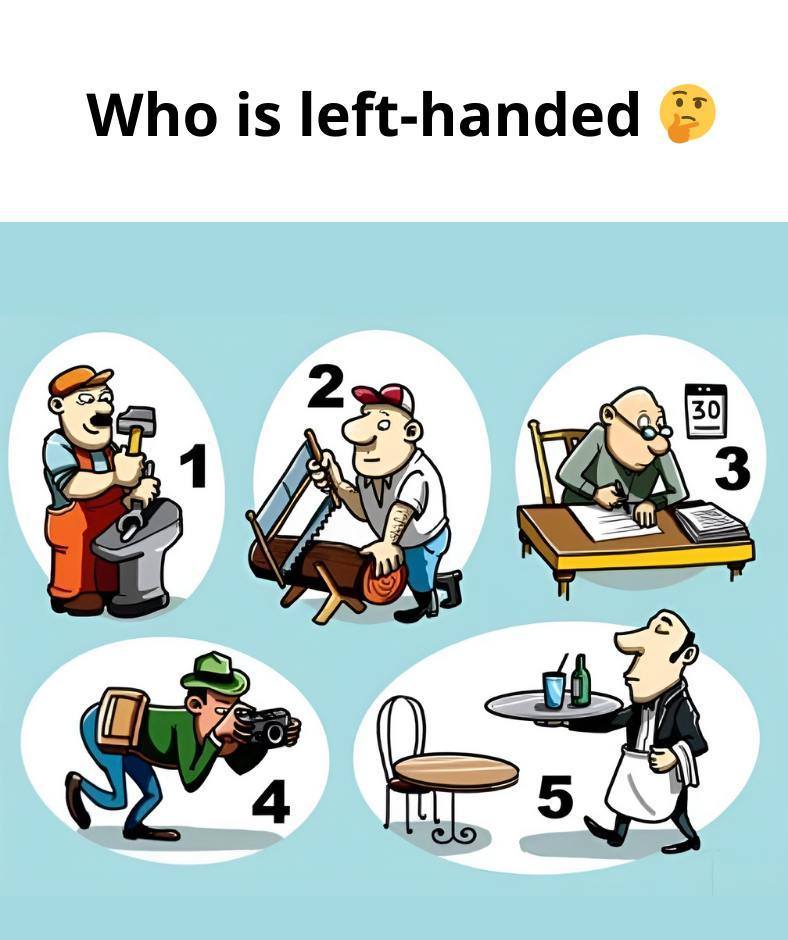Have you ever looked at a seemingly simple puzzle and found yourself scratching your head? Sometimes, it takes a bit of perspective-shifting to solve the trickiest riddles. Today, we’re diving into a classic puzzle that will put your observation and deduction skills to the test. Here’s the challenge:
Imagine you’re looking at an image of five people, each doing a different task. Your goal? Figure out which of these five individuals is left-handed. While it might seem obvious at first, this puzzle has fooled plenty of people, so let’s break down each person’s actions and look for subtle clues to help us identify the left-handed character.
Common Missteps When Solving This Puzzle

People often get tripped up by their assumptions. For example, it’s easy to assume that a person holding something in their left hand must be left-handed. But identifying a person’s dominant hand usually requires more context, especially when tasks and tools come into play.
This puzzle is especially tricky because:
- People rely on stereotypes rather than actual clues.
- Objects in hand don’t always indicate handedness. Some tools are designed to be held a certain way.
- Lack of attention to body positioning can lead to overlooking the most telling details.
This puzzle cleverly hides clues that indicate who is actually left-handed. Let’s analyze each character in the image to find out who stands out.
Step-by-Step Analysis of Each Person
Let’s examine each person in the puzzle and consider how they’re handling their task.
Person 1: The Plumber
The plumber is focused on fixing a sink, using a hammer in one hand. Many people quickly assume the hand holding the hammer must be the plumber’s dominant hand. However, using tools doesn’t always reveal true handedness; some people use their non-dominant hand to brace while working. Since this action doesn’t provide a clear answer, we’ll need to keep looking.
Person 2: The Carpenter
Next, we have a carpenter using a saw. Typically, saws are designed for right-handed use, meaning a left-handed person might hold the wood steady with their left hand. However, this isn’t a strong enough clue, as anyone can adapt to use a saw comfortably. So, while intriguing, this clue isn’t conclusive.
Person 3: The Office Worker
An office worker is writing at a desk. Some might assume this is a dead giveaway for handedness, especially if the worker appears to be writing with a particular hand. But in reality, people sometimes use either hand for writing based on the setup. Without additional context, this character’s actions don’t provide enough insight into their true dominant hand.
Person 4: The Photographer
The photographer is holding a camera and positioning themselves to capture a shot. Cameras are often built for right-handed operation, with buttons and controls on the right side, so a left-handed person could still appear to use their right hand for taking pictures. This detail doesn’t reveal much about their dominant hand, so let’s look at the last person.
Person 5: The Waiter
Finally, we see a waiter carrying a tray. This seemingly small detail is actually the most revealing clue. Waiters generally hold trays with their non-dominant hand, keeping their dominant hand free for other tasks, like arranging items on the tray or serving food. In this case, the waiter is carrying the tray with their right hand, which suggests their dominant hand—the left—is free to handle other tasks. This detail indicates that the waiter is likely left-handed.
The Solution: Person 5 Is Left-Handed
After analyzing each character, we conclude that Person 5, the waiter, is the left-handed individual. The key here is understanding that the tray is in their right hand, a choice that keeps their dominant left hand free for more precise tasks.

Why Paying Attention to Small Details Matters
The puzzle serves as a reminder of the importance of small details. In this case, the waiter’s tray-holding hand was the main clue that revealed their dominant hand. This puzzle teaches us to look beyond surface-level assumptions and consider practical reasons for each action.
In puzzles and in real life, assumptions can easily mislead us. Learning to look closely at context, positioning, and behavior can uncover the truth in ways that initial impressions might miss. Here, the waiter’s subtle choice of which hand holds the tray was the key to solving the puzzle.
Join the Discussion: Did You Get It Right?
Did you guess that the waiter was the left-handed person, or were you surprised by the answer? Let us know in the comments how you approached the puzzle and whether you spotted the key detail right away. If you found this puzzle tricky, don’t worry—it’s all about having fun and sharpening your skills. Share this post with friends and family to see if they can solve it as quickly as you did!
Keep Your Brain Sharp with More Puzzles
If you enjoyed this puzzle, there are plenty more out there to test your logic, reasoning, and observation skills. Puzzles like these encourage us to think critically, step outside assumptions, and pay attention to details. Regularly solving these kinds of challenges can improve your cognitive skills and make you more adept at noticing subtle cues.
The next time you come across a puzzle or riddle, remember to take a closer look—you never know when a seemingly minor detail will reveal the answer. So keep puzzling, keep thinking, and enjoy the process of solving each new challenge!

Leave a Reply